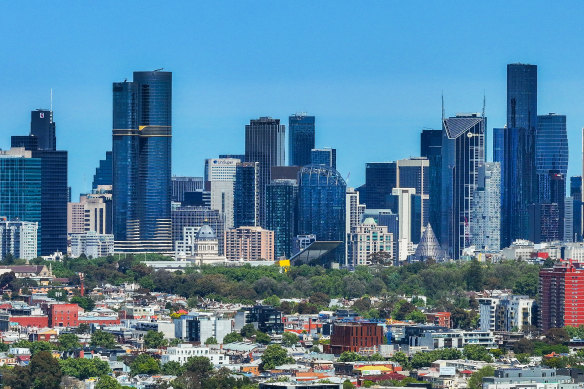This was published 11 months ago
Melbourne in the grip of baby drought as rent becomes ‘a great contraceptive’
By Josh Gordon
Melbourne is Australia’s least fertile state capital, with birth rates plunging across inner and middle suburbs as a lack of affordable housing and other cost-of-living pressures force growing numbers of people to shelve plans for children.
Nationally, 289,100 babies were born last year, down 4.6 per cent compared with 2022. It was the lowest annual level since 2006, and the largest annual drop since 1975, when Australia was battling stagflation, a dreaded combination of soaring inflation and low growth.

The drop in birth rates is particularly steep in Melbourne’s inner and middle suburbs.Credit: Joe Armao
Analysis from accounting firm KPMG suggests the baby drought is particularly acute across inner and middle Melbourne suburbs now deemed to be unaffordable for younger people.
It comes as the Allan government steps up ambitious plans to build an average of 80,000 new homes a year for the next decade to tackle housing affordability issues. Data released by the Australian Bureau of Statistics last week suggests the state is falling short, with just 51,512 new homes started over the year to March, the lowest number in a decade.
The KPMG analysis found 56,270 babies were born in Greater Melbourne in 2023 – 7.3 per cent fewer than in 2019, just before a series of rolling lockdowns linked to the COVID-19 pandemic upended the city.
That equates to a fertility rate – measuring the average number of children a woman would have over her childbearing years based on current trends – of just 1.44 for Melbourne, compared to 1.57 in Sydney and 1.61 in Brisbane.
But in many suburbs fertility rates were far lower.
In parts of the CBD, home to large numbers of students living in high-density housing not well-designed for families, fertility rates were as low as 0.36. Across inner and middle suburbs, including Collingwood, Carlton, Fitzroy, Brunswick, Box Hill, Richmond, Northcote, Hawthorn and Essendon, fertility rates were well below one.
KPMG economist Terry Rawnsley said the end of the pandemic led to a huge spike in births, with record-low unemployment, historically low interest rates, stimulus payments and high savings rates encouraging people to start having children again.
But he said rising prices had placed families under growing levels of financial stress, meaning Melburnians were once again putting off having children.
“We haven’t seen such a sharp drop in births in Australia since the period of economic stagflation in the 1970s, which coincided with the initial widespread adoption of the contraceptive pill,” Rawnsley said.
“Young families are being pushed to the edges of Melbourne, where there is cheaper housing that can accommodate their children.”
All 10 of the suburbs in Melbourne with the highest fertility rates were situated in greenfield areas, particularly in the high-growth suburbs to the city’s west, including Cobblebank, Strathtulloh, Clyde North, Tarneit, Mount Cottrell and Mickleham.
“This combination of the pandemic and rapid economic changes explains the spike and subsequent sharp decline in birth rates we have observed over the past four years,” Rawnsley said.
Nationally, Australia’s fertility rate has been declining for years, from an average of more than two children per woman in 2008 to about 1.6 in 2023, with the ageing population more dependent than ever on strong overseas migration.
Demographer Matthew Deacon, from Demographic Solutions, said that across a large part of Melbourne the reality of renting was “acting as a great contraceptive”, along with other pressures faced by younger people, such as higher education debts and the reality of living with parents or in group houses for longer.
“There are young people now who are doing between five and seven years more education than their parents, and probably 10 years more than their grandparents,” Deacon said. “Obviously, that means they are getting around to making decisions such as children much later.”
Oxford Economics Australia’s head of property and building forecasting, Timothy Hibbert, said a lack of appropriate housing for families in inner and middle suburbs also represented a major barrier to boosting fertility rates. He said the birth data, particularly for Victoria, remained very weak.
“People are having fewer kids than they otherwise would prefer, and at the core of that is affordability and having to work enough hours,” Hibbert said.
He said the cost of getting a house with a third bedroom that was appropriate for children remained substantial in Melbourne and Sydney, particularly in middle suburbs.
“It’s a big jump up in costs and, ultimately, to service that a really large uplift in income or a substantial body of savings is needed or support from parents to meet repayments.”
Modelling by Infrastructure Victoria has found that buying a three-bedroom house anywhere near the city, or even in Melbourne’s middle suburbs, is now out of the question for a household earning $88,021 a year – a typical wage for many essential service workers.
Rawnsley said regional areas fared better than the cities. The analysis found births in regional Victoria declined by just 0.4 per cent to 16,060 over the four years to 2023.
“Births across most regions have returned to pre-pandemic levels as the baby boom driven by younger Australians shifting to the regions ran out of steam,” he said.
Get the day’s breaking news, entertainment ideas and a long read to enjoy. Sign up to receive our Evening Edition newsletter here.